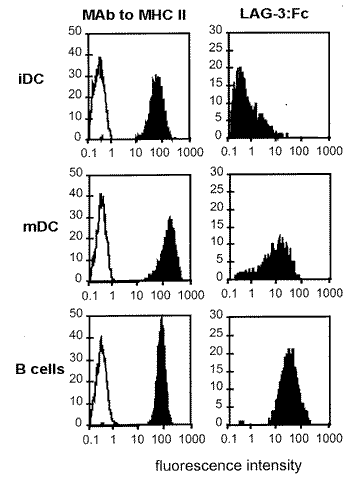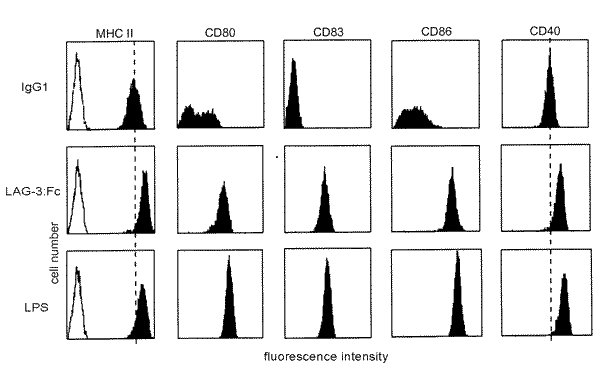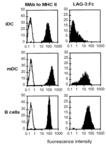Product Details
| Alternative Name: | Lymphocyte activation gene-3, FDC protein, CD223 |
| |
| MW: | ~80kDa (SDS-PAGE). |
| |
| Source: | Produced in CHO cells. The sequence coding for the 4 extracellular Ig-like domains of human LAG-3 (D1-D4) is fused to the Fc portion of human IgG1. |
| |
| UniProt ID: | P18627 |
| |
| Formulation: | Liquid. In PBS. |
| |
| Purity: | ≥99% (SDS-PAGE) |
| |
| Endotoxin Content: | <0.1EU/mg purified protein (LAL test; Bio Whittaker). |
| |
| Specificity: | Binds to human, mouse and monkey MHC class II. |
| |
| Biological Activity: | Inhibits binding of MAb to LAG-3 (human) to LAG-3. Induces maturation of human dendritic cells. |
| |
| Applications: | ELISA, Flow Cytometry
|
| |
| Application Notes: | Flow Cytometry: Detection of MHC class II molecules in combination with fluorescently labelled Ab to IgG1. |
| |
| Shipping: | Blue Ice |
| |
| Long Term Storage: | -20°C |
| |
| Use/Stability: | Stable for at least 6 months after receipt when stored at -20°C. |
| |
| Scientific Background: | The lymphocyte activation gene-3 (LAG-3, CD223), a member of the immunoglobulin superfamily (IgSF) related to CD4, binds to the major histocompatibility complex (MHC) class II molecules but with higher affinity than CD4. Several alternative mRNA splice-variants of human LAG-3 have been described, two of them encoding potential secreted forms: LAG-3V1 (i.e. the D1-D2 domains of the protein, 36 kDa) and LAG-3V3 (D1-D3, 52 kDa). The longer form was detected by ELISA in the serum of healthy individuals as well as of tuberculosis patients with a favorable outcome. LAG-3 expression by T cell clones correlated with IFN-γ production, and hence soluble LAG-3 has been suggested as a serological marker of Th1 responses. |
| |
| Regulatory Status: | RUO - Research Use Only |
| |

Figure 1: Binding of LAG-3 (human):Fc (human) (rec.) (Prod. No.
ALX-522-078) on dendritic and B cells.
Method: Monocyte-derived immature DC (iDC), DC matured for 48h with LPS (mDC) and EBV-transformed B-cells are incubated with either an anti-MHC class II MAb (10µg/ml) or LAG-3 (human):Fc (human) (rec.) (10µg/ml) for 30 min. at 4°C in PBS/1% BSA. The cells are then stained for 30 min. at 4°C with FITC-labeled goat anti-human Fc antibodies. The open histograms correspond negative control labeling [3]. "

Figure 2: rhLAG-3:Fc-induced dendritic cells (DC) maturation.
Method: Immature DC derived from human monocytes, resuspended at 1x10
6 cells/ml in complete culture medium, are incubated with LAG-3 (human):Fc (human) (rec.) (Prod. No.
ALX-522-078) (10µg/ml), LPS (positive control, 5µg/ml) or human IgG1 (isotype-matched negative control, 10µg/ml) for 48 hours. DC maturation induced by rhLAG-3:Fc binding to MHC class II or LPS is assessed by the increased expression of MHC Class II, CD80, CD83, CD86 and CD40 [3]."
Please mouse over
Product Literature References
Elevated expression of LAG-3, but not PD-1, is associated with impaired iNKT cytokine production during chronic HIV-1 infection and treatment : J.A. Juno, et al.; Retrovirology
12, 17 (2015),
Application(s): ELISA,
Abstract;
Full Text
A soluble form of lymphocyte activation gene-3 (IMP321) induces activation of a large range of human effector cytotoxic cells: C. Brignone, et al.; J. Immunol.
179, 4202 (2007),
Abstract;
A soluble lymphocyte activation gene-3 (sLAG-3) protein as a prognostic factor in human breast cancer expressing estrogen or progesterone receptors: F. Triebel, et al.; Cancer Lett.
235, 147 (2006),
Abstract;
LAG-3 (CD223) reduces macrophage and dendritic cell differentiation from monocyte precursors: S. Buisson & F. Triebel; Immunology
114, 369 (2005),
Abstract;
Maturation and activation of dendritic cells induced by lymphocyte activation gene-3 (CD223): S. Andreae, et al.; J. Immunol.
168, 3874 (2002),
Abstract;
Full Text
T cell major histocompatibility complex class II molecules down-regulate CD4+ T cell clone responses following LAG-3 binding: B. Huard, et al.; Eur. J. Immunol.
26, 1180 (1996),
Abstract;
CD4/major histocompatibility complex class II interaction analyzed with CD4- and lymphocyte activation gene-3 (LAG-3)-Ig fusion proteins: B. Huard, et al.; Eur. J. Immunol.
25, 2718 (1995),
Abstract;
General Literature References
A soluble lymphocyte activation gene-3 (sLAG-3) protein as a prognostic factor in human breast cancer expressing estrogen or progesterone receptors: F. Triebel, et al.; Cancer Lett.
235, 147 (2006),
Abstract;
LAG-3: a regulator of T-cell and DC responses and its use in therapeutic vaccination: F. Triebel; Trends Immunol.
24, 619 (2003),
Abstract;
Active tuberculosis in Africa is associated with reduced Th1 and increased Th2 activity in vivo: C. Lienhardt, et al.; Eur. J. Immunol.
32, 1605 (2002),
Abstract;
Expression and release of LAG-3-encoded protein by human CD4+ T cells are associated with IFN-gamma production: F. Annunziato, et al.; FASEB J.
10, 769 (1996),
Abstract;












